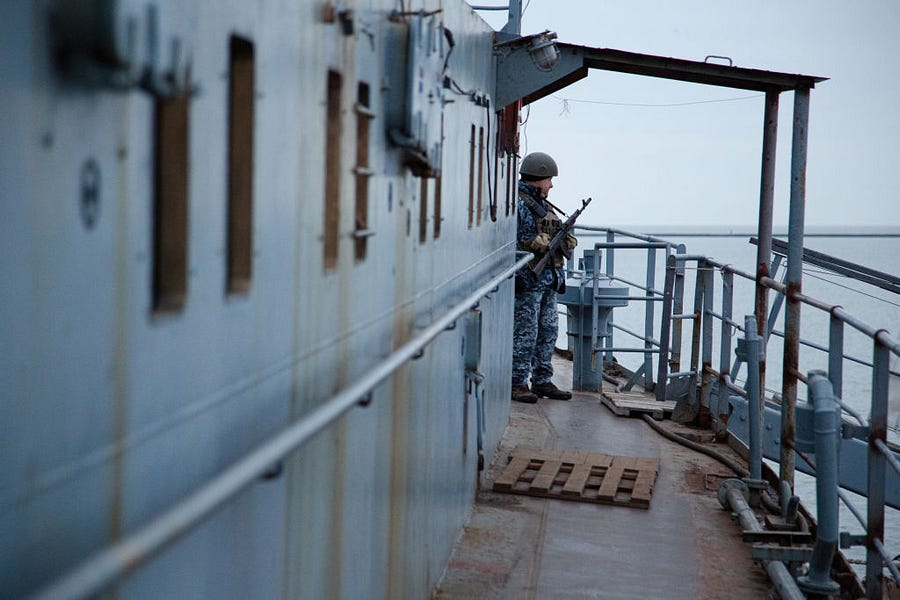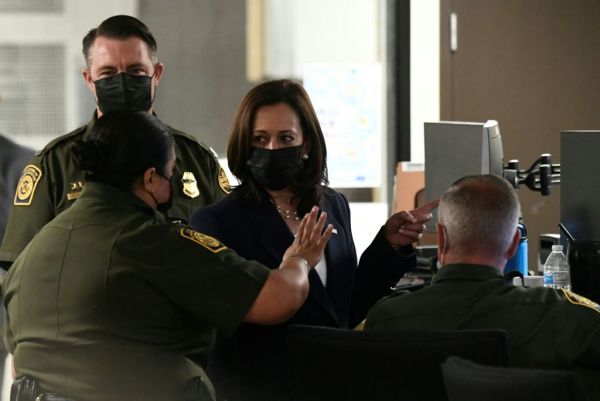Over the weekend I interviewed retired Capt. Andrii Ryzhenko, a 35-year veteran of the Ukrainian and Soviet navies. He served at NATO headquarters in Mons, Belgium, between 2006 and 2010, working on naval combat readiness evaluation. After the start of war with Russia in 2014, Ryzhenko headed up the Ukrainian navy’s Euro-Atlantic integration and was one of the core developers of the Ukrainian navy’s new strategy. In 2020 he was the assistant minister of defense of Ukraine, working on maritime security and policy on Ukrainian navy development. He is a graduate of the Sevastopol Naval Academy and the U.S. Naval War College. This interview has been edited for length and clarity.
Andrew Fink: Could you set the stage from before the war: What was the state of the Ukrainian navy and the Russian navy before the war and what were you guys planning for?
Capt. Andrii Ryzhenko: After the annexation of Crimea in 2014, the Ukrainian navy lost most of the fleet. We lost 70 percent of the people and we lost 75 percent of the equipment. When we got to Odesa, [the new naval headquarters, on the northwest corner of Black Sea] we understood that we cannot carry on the same as we did before, and also we needed support from our partners. This brings us to our long-term naval planning. There were many attempts at planning, a lot of internal friction etc., but finally in 2018 we created our naval strategy. This was a long-term document that described how the Ukrainian navy would develop between 2018 and 2035. We divided this into three periods, and each period was aimed at a certain goal. The obvious primary threat was Russia, but also we made some references to the changing geopolitical environment, to technological advances. We should not be frozen into the Soviet military industry like Ukraine used to be because of internal institutional compromise and corruption.
In the first stage we had to ensure our primary task: to defend our country from aggression. During this first stage we were thinking about defending the closest Ukrainian maritime area, the sea that is about 40 nautical miles from the coast. The area we are talking about is the northwestern part of the Black Sea, an area of around 100 by 150 nautical miles between the coast and Russian-occupied Crimea, and also the northern part of the Sea of Azov.
We identified three capability priorities for this first stage: 1) maritime domain awareness, 2) sea denial, and 3) sea control. And we started to think about what concrete platforms we needed to accomplish these goals. These were: a surface fleet, marines, coastal artillery, maritime radars, and so on. And we were also thinking about what kind of budget we had, and within this we tried to balance with what we should do.
When we showed this plan to our partners, they said “Okay, we can help.” Our [naval] partners are the U.S., the U.K., Turkey, Poland, Lithuania, and many other countries, mostly NATO countries. Some were helping us with weaponry, some with training, some by providing courses. Obviously our partners No. 1 and No. 2 were the U.S. and U.K.
Before the war we built eight Gurza class [armored artillery] boats, but this was probably not because the Navy needed them, but because our industry could build them. When they offered us these boats they promised us a much different capability in comparison to what appeared when it was actually in the water. This ship was a riverine ship, and also it did not have any missiles system, and it should have a short-range missile system with a range of 5 kilometers. For a policing boat, it is okay to lack missiles, but for maritime combat with Russia, no.
We got four Island class boats from the U.S., but these were without weaponry. Ukraine could get some weapons, but there was a long delay in the decision about what weapons to put on these boats. Unfortunately, when it was finally decided, it was too late to install [in time for the war]. We also have some Soviet-era boats, some amphibious boats, around 20 other Soviet patrol boats. These have certain capabilities but are very very limited.
Most importantly, we don’t have anything for maritime sea denial—specifically anti-ship missiles. There was some work to develop this Ukrainian Neptune anti-ship missile. This was mainly reported in the media starting in 2017. A unit that used this system was even created, but the missile is still not ready.
Our big naval advantage going into this fight is coastal defense. It’s marines and artillery. During the last seven years we increased the number of Ukrainian marines from 300 to 12,000, and also artillery. And we really trained them during these years. They were even deployed [in Donbas], and a good example of their capability now is what is going on today in the city of Mariupol. For the last three weeks they have been defending this city with a ratio of one Ukrainian defender to five Russian attackers, and the Russians can’t do anything. In fact yesterday, the commander of the marine brigade in Mariupol was awarded the “Hero of Ukraine” decoration. Right now the situation is very, very serious in Mariupol. They are still fighting.
Fink: And what was the state of the Russian Black Sea Fleet before the war started?
Ryzhenko: Since 2014 the Russians started to re-equip their Black Sea fleet, and their core idea was striking capability, to build a “bastion” on Crimea. This bastion had a number of layers, and the first layer was to repel all neighbors in the Black Sea moving toward their “territorial” sea (the northern Black Sea). They brought a lot of new ships [to Crimea]. The plan was to have six of the newest Russian frigates there, modified Russian Krivak class frigates, but they could only build three because Ukraine refused to provide them with gas turbines. One of these ships has already fired on Ukraine during the current fighting. Another is in dry dock, and the other is currently in the Mediterranean. They also brought some of the Project 22160 patrol ships, which carry eight Kalibr cruise missiles each. They also brought a lot of submarines, six, to the Black Sea during these years, and these are currently launching missiles against Ukraine.
Currently they have 60 combat ships on the Black Sea, which is one-tenth the size of the old Soviet Black Sea fleet. However, their combat capability, especially with missiles, became significant. It is not too much, but much more than Ukraine, Bulgaria, or Romania. They did a lot of strike exercises on how they could neutralize the Ukrainian navy.
They planned on neutralizing the Ukrainian navy both with strikes and in an asymmetric way, agents of influence, business connections, etc.
Fink: Tell us about the course of the war at sea so far.
Ryzhenko: First of all, Russia infiltrated sabotage teams into all Ukrainian ports. This started six months before this war started. Sabotage teams were activated for different kinds of sabotage. Secondly they conducted air strikes. They planned to destroy all command posts, all communications, and armament warehouses. On February 24 they launched, I believe, 150-plus missiles. And thirdly they started informational warfare. I remember waking up [on February 24] at 5 o’clock or something … and already in the media there were “Russians landing in Odesa, in Mariupol” headlines. This event was still very far away, but someone put this in the media. They were still not even thinking about landing in Odesa.
Fink: Could you explain why the Russians would spread that kind of disinformation?
Ryzhenko: They want people in Ukraine and in the West [to] see everything is just falling down in the news, so you are disabled mentally, you cannot resist. When I saw in the morning of February 24 “Odesa: Landing Operation,” very quickly I thought “What is this s**t?” I called some contacts, and the guys there said “We don’t see anybody. Yes, we shot down a couple of aircraft, we shot down a couple of missiles, but we don’t see any landing operation.” The same in Mariupol.
If we speak about the port of Odesa, it is quite well-defended. It has naval forces defending it, land forces, and air forces, and the national guard [there] has quite a few units.
There were already two or three [Russian] landing attempts against Ukraine. The first and second ones did not happen because of mutinies aboard. Most of the troops which were aboard those landing ships have already disembarked and are fighting in Mariupol. This is naval infantry from the 810th Brigade, from Sevastopol. Most of them have already been killed in Mariupol.
In general, speaking about the war at sea, our ships just can’t compete with Russian ships due to lack of sea denial capability, even short range, such as 5 or 6 kilometers.
We lost an Island class boat, the Slovyansk [formerly the U.S. Coast Guard ship Cushing]. She was patrolling the coast of Odesa oblast to identify landing forces. She had a 25mm gun, but this is nothing. The Ukrainian navy should have accepted much earlier what they were actually offered to install, which was a [British] 30mm MSI gun, and they are quite good for air defense. For some reason they were still thinking about this, so when the war started we just had this 25mm gun from around WWII, which does not work against air targets.
Fink: Is there anything the U.S. or other Western countries can give to the Ukrainian navy right now that would increase their capabilities?
Ryzhenko: What we need is sea denial. Normally sea denial capabilities come from anti-ship missiles, electronic warfare, and naval mines. This task could also be accomplished by drones. I know that Ukraine is getting some of these American switchblade drones. We may try them for maritime and amphibious warfare.
For sea control, we will need capable boats. I’m talking about the American Mark 6 boats that are getting built, which are already destined for Ukraine. We should receive these with weapons already installed on them, with artillery and with missiles on them. The Mark 6 is very fast and we could use them in counter-landing operations and also to control our coastline.
We should also arm the Island class boats with artillery and missile weapons.
Again, what is important is that these capabilities must be asymmetric toward the enemy. The asymmetric capabilities we need have to have three pillars: 1) Its new technology is unknown and a surprise for enemy, 2) Russia does not have significant experience countering it, and 3) It is shown to be effective, so our guys are more confident. For example, I would consider the NLAW and Javelin anti-tank missiles to be asymmetric capabilities along these lines for land warfare. For the sea, I’m talking about missiles and drones: air drones, surface drones, and even sub-surface drones. By using them with motivated personnel and with smart tactics, it is possible to beat a bigger enemy.








Please note that we at The Dispatch hold ourselves, our work, and our commenters to a higher standard than other places on the internet. We welcome comments that foster genuine debate or discussion—including comments critical of us or our work—but responses that include ad hominem attacks on fellow Dispatch members or are intended to stoke fear and anger may be moderated.